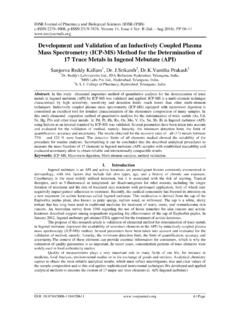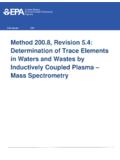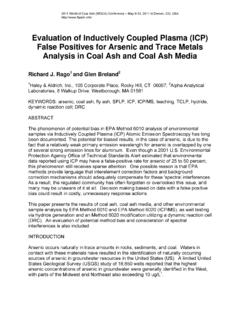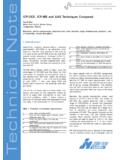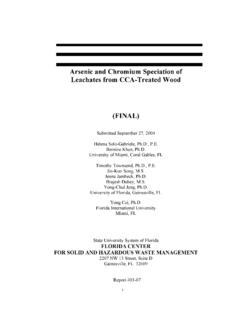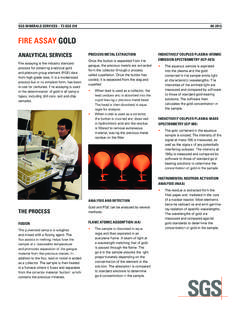Transcription of ICP-OES and ICP-MS Detection Limit Guidance
1 ICP-OES and ICP-MSDetection Limit Guidance 2007 Evans Analytical Group, LLC Printed in USA 08/07 BR0233Li5 AtomicNumberSymbolICP-OES Solution DL ( g/L) Solid DL (ppm wt) 29Cu 11Na 12Mg 13Al 14Si 15P 16S 17Cl 18Ar 1H 4Be 37Rb 55Cs 42Mo 41Nb 86Rn 74W 43Tc 75Re 44Ru 76Os 45Rh 77Ir 46Pd 78Pt 47Ag 79Au 48Cd 80Hg 60Nd 62Sm 63Eu 64Gd 65Tb 61Pm 66Dy 67Ho 68Er 69Tm 49In 50Sn 51Sb 52Te 53I 81Tl 82Pb 83Bi 84Po 85At 58Ce 59Pr 70Yb 90Th 92U 93Np 94Pu 95Am 96Cm 91Pa 97Bk 98Cf 99Es 100Fm 101Md 102No 105 107 106 108 109 111 110 112 DbSgHsBhMt Uun Uuu 114 116 3Li 10Ne 2He 9O 8F 7N 6C 5B 57La 89Ac 71Lu 103Lr 87Fr 88Ra 104Rf 72Hf 40Zr 39Y 38Sr 56Ba 73Ta 54Xe 19K 20Ca 21Sc 22Ti 30Zn
2 31Ga 32Ge 33As 34Se 35Br 36Kr 23V 24Cr 25Mn 26Fe 27Co 28 NiUubUuqUuhPeriod1654327 LanthanidesActinidesGroup1IA2 IIA3 IIIB4 IVB5VB6 VIB7 VIIB9 VIII81011IB12 IIB13 IIIA14 IVA15VA16 VIA17 VIIA18 VIIIATo convert g/L to ppm wt, use the following calculation:[sol conc ( g/L) * prep vol (L)] / sample mass (g) = sample concentration in ppm wt (mg/Kg) gICP-OES sample mass50 mlICP-OES prep volume1 Solution dilution to run on ICP-OES500 Typical ICP-OES dilution gICP-MS sample mass100 mlICP-MS prep volume1 Solution dilution to run on ICP-MS2,000 Typical ICP-MS dilution factorThe Detection limits are theoretical best case scenarios assuming there are no spectral interferences affecting the best isotope or wavelength for a given element.
3 For any given determination, the actual method Detection Limit can be an order of magnitude higher or more. Use this as a guide, not absolute information Solution DL ( g/L) Solid DL (ppm wt) 2007 Evans Analytical Group, LLC Printed in USA 08/07 BR023 inductively coupled plasma SpectroscopyEAG Locations United StatesArizona903 S. Rural Road, #101-388 Tempe, AZ 85281 480 239-0602 602 470-2655 810 Kifer Road Sunnyvale, CA 94086 408 530-3500 408 530-3501 Fax 1135 E. Arques Avenue Sunnyvale, CA 94085 408 738-3033 408 738-3035 Fax 785 Lucerne Drive Sunnyvale, CA 94085 408 737-3892 408 737-3916 FaxMassachusetts10 Centennial DrivePeabody, MA 01960978 278-9500978 278-9501 Lake Drive EastChanhassen, MN 55317952 828-6411952 828-6449 Jersey 104 Windsor Center Dr.
4 , Ste. 101 East Windsor, NJ 08520609 371-4800609 371-5666 York SHIVA Technologies6707 Brooklawn ParkwaySyracuse, NY 13211315 431 9900315 431 9800 Carolina616 Hutton St., Ste. 101 Raleigh, NC 27606 919 829-7041 919 829-5518 Round Rock West Dr., Ste. 100 Round Rock, TX 78681512 671- 9500512 671- 9501 LocationsEvans Analytical Group - ShanghaiSte. 102, Building 44, 1387 Zhangdong RoadPudong Area, Shanghai, China 20120486 21 6879 608886 21 6879 9086 Technologies Europe SAS94, chemin de la Peyrette31170 Tournefeuille, France33 5 61 73 15 2933 5 61 73 15 67 Scientifi c GmbHIndustriepark H chst, Building G 865D-65926 Frankfurt am Main, Germany 49 (0) 693053213 49 (0) 69307941 Science Corporation7F, Sumitomo Bldg.
5 , Higashi Ikebukuro 1-10-1 Toshima-Ku, Tokyo 170-0013, Japan 81 3 5396 053181 3 5396 1930 Taiwan LLC5F-1, No. 31 PuDing RoadHsinChu, Taiwan, 300 3 5632303886 3 5632306 Scientifi c Building Brunel Science Park Uxbridge UB8 3PH, (0) 1895 81119444 (0) 1895 810350 coupled plasma Spectroscopy techniques are "wet" sampling methods where samples are introduced in liquid form for analysis. In plasma emission spectroscopy (OES), a sample solution is introduced into the core of inductively coupled argon plasma (ICP), which generates temperature of approximately 8000 C.
6 At this temperature all elements become thermally excited and emit light at their characteristic wavelengths. This light is collected by the spectrometer and passes through a diffraction grating that serves to resolve the light into a spectrum of its constituent wavelengths. Within the spectrometer, this diffracted light is then collected by wave-length and amplifi ed to yield an intensity measurement that can be converted to an elemental concentration by comparison with calibration standards. In plasma mass spectroscopy (MS), the inductively coupled argon plasma (ICP) is once again used as an excitation source for the elements of interest.
7 However in contrast to OES, the plasma in ICP-MS is used to generate ions that are then introduced to the mass analyzer. These ions are then separated and collected according to their mass to charge ratios. The constituents of an unknown sample can then be identifi ed and measured. ICP-MS offers extremely high sensitivity to a wide range of LimitationsUp to 70 elements can be determined simultaneously in a single sample analysis. The emission spectra are complex and inter-element interferences are possible if the wave-length of the element of interest is very close to that of another element.
8 The useful working range is over several orders of Mass Spectrometry, the common matrix elements and other molecular species can interfere with the measurement of some elements. Doubly charged or molecular ionic species can create diffi culties in quantifi is suitable to automation, thus enhancing accuracy, precision and throughput. The sample to be analyzed must be digested prior to analysis in order to dissolve the element(s) of interest.

